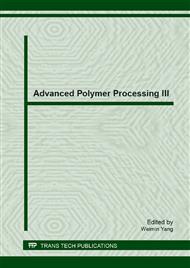[1]
W. Xu, A. Nikolov, D. T. Wasan, A. Gonsalves, and R. P. Borwankar, Foam film rheology and thickness stability of foam-based food products, Colloids and Surfaces A: Physicochem, Eng. Aspects 214 (2003) 13-21.
DOI: 10.1016/s0927-7757(02)00364-3
Google Scholar
[2]
D. Exerowa and P. M. Kruglyakov, Foam and Foam Films: Theory, Experiments, Application, Elsevier, 1998.
Google Scholar
[3]
W. R. Rossen, Foams in enhanced oil recovery. In: R. K. Prud'homme and S. Khan (Eds), Foams: Theory, Measurements and Applications,Marcel Dekker ,1996,pp.413-464.
DOI: 10.1201/9780203755709-11
Google Scholar
[4]
J. Ali, R. W. Burley and C. W. Nutt, Foam Enhanced Oil-Recovery from Sand Packs, Chemical Engineering Research and Design, 63 (1985) 101-111.
Google Scholar
[5]
W. Lake, Enhanced Oil Recovery, Prentice Hall ,1989.
Google Scholar
[6]
L. W. Holm, The Mechanism of Gas and Liquid Flow through Porous Media in the Presence of Foam, Society of Petroleum Engineers Journal, 8 (1968) 359-369.
DOI: 10.2118/1848-pa
Google Scholar
[7]
T. W. Patzek, Field Application of Foam for Mobility Improvement and Profile Control, SPE Reservoir Engineering, 11 (1996) 79-86.
DOI: 10.2118/29612-pa
Google Scholar
[8]
S. A. Zhdanov, A. V. Amiyan, L. M. Surguchev, L. M. Castanier and J. E. Hanssen, Application of Foam for Gas and Water Shut-off: Review of Field Experience, SPE 36914 in European Petroleum Conference held in Milan, Italy (1996).
DOI: 10.2118/36914-ms
Google Scholar
[9]
A. T. Turta and A. K. Signhal, Field Foam Applications in Enhanced Oil Recovery Projects: Screening and Design Aspect,SPE 48895 in SPE International Oil and Gas Conference and Exhibition in China (1998).
DOI: 10.2118/48895-ms
Google Scholar
[10]
D. Megías-Alguacil,P. Fischer,and E. J.Windhab,Determination of the interfacial tension of low density difference liquid–liquid systems containing surfactants by droplet deformation methods, Chemical Engineering Science,61 (2006) 1386-1394.
DOI: 10.1016/j.ces.2005.08.037
Google Scholar
[11]
Y. Liu, R.B. Grigg, and R.K. Svec, CO2 Foam Behavior: Influence of Temperature, Pressure, and Concentration of Surfactant, SPE 94307, 5 (2005) 1-13.
DOI: 10.2118/94307-ms
Google Scholar
[12]
L. W. Holm, Evolution of the Carbon-Dioxide Flooding Processes, J. Pet. Technol, 39 (1987) 1337-1342.
Google Scholar
[13]
L. W. Holm and A. Josendal, Mechanism of Oil Displacement by Carbon Dioxide, J. Pet. Technol. 26 (1974) 1427-1438.
DOI: 10.2118/4736-pa
Google Scholar
[14]
J. S. Kim,Y. Dong, and W. R. Rossen, Steady-State Flow Behavior of CO2 Foam, SPE J., 4 (2004) 405-414.
Google Scholar
[15]
D.X. Du and P.L.J. Pacelli, Carbon Dioxide Foam Rheology in Porous Media: A CT Scan Study, SPEJ, 12 (2007) 245-252.
DOI: 10.2118/97552-pa
Google Scholar
[16]
F. Khalil, Bantrel Inc and K. Asghari, Application of CO2-Foam as a Means of Reducing Carbon Dioxide, Journal of Canadian Petroleum Technology, 45 (2006) 37-42.
DOI: 10.2118/06-05-02
Google Scholar
[17]
Quoc P. Nguyen, Dynamics of foam in porous media, PhD dissertation, Delft University of Technology, The Netherlands, 2004.
Google Scholar
[18]
D .Weaire and S. Hutzler, The Physics of Foams, England: Oxford University Press, 1999.
Google Scholar
[19]
K. L. Wang and D. F. Leng, Foam Performance Evaluation indoor of the HY-3 surfactant, Petroleum Geology & Oilfield Development in Daqing, 3 (2008) 106-109.
Google Scholar
[20]
H. B. Wang and X. M. Xiao, Foam flooding system stability and foam stabilization mechanism, Drilling & Production Technology, 31 (2008) 117-120.
Google Scholar
[21]
Q. Wang and H. L. Xi, Review on measurement techniques of performance and influence factors of stability for foam, Journal of Chemical Industry &Engineering, 28 (2007) 25-29.
Google Scholar
[22]
G. X. Zhao and B. Y. Zhu, The principle of the surfactant, China Light Industry Press, 2003, pp.548-550.
Google Scholar
[23]
L.J. Wang, G.Y. Zhang, and J.F. Dong, Progress in test and evaluation methods for foaming performance, China Surfactant Detergent & Cosmetics, 35 (2005) 171-173.
Google Scholar
[24]
Z.M. Li, Foam fluid applications in oil and gas exploitation, Petroleum Industry Press, 2010.
Google Scholar
[25]
Y. Li, The Research of Seepage Properties of the Air Liquid Foam in Porous Media, Qingdao University of Science and Technology (2012).
Google Scholar
[26]
W. J. Lu, The Research of Seepage Properties of the CO2 Liquid Foam in Porous Media, Undergraduate thesis, Qingdao University of Science and Technology (2012).
Google Scholar


